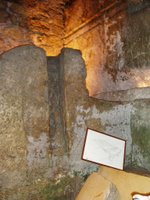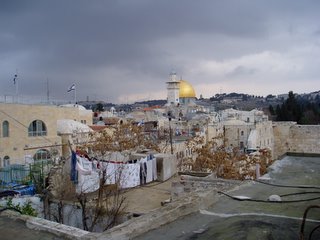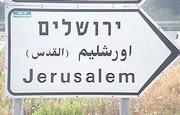Asara B'Tevet in Israel
י״א טבת, תשס״ו
As a parallel to my last post, what more relevant way to spend a fast day mourning the beginning of the Roman siege of Jerusalem than to tour the entire length of the Western Wall of the Temple Mount, in a tunnel under the Muslim Quarter of the Old City? And then to visit the Machon Mikdash, an institute dedicated to illustrating and replicating Temple paraphernalia in preparation for the third iteration...


An underground portion of the kotel, and the unfinished cornerstone on the northern end of the same. Just a shot I couldn't resist...
Just a shot I couldn't resist...
 Oh, and another one ;-)
Oh, and another one ;-)
Chanuka in Israel
ב׳ טבת, תשס״ו
One of my teachers asked, at the beginning of this week, for each of us to say what we found most special about Chanuka in Israel. Some people said that it wasn't competing with Xmas, but I found that to be a rather negative way of expressing what I think was the same sentiment I had: that in Israel, Chanuka -- like all the other chagim in their respective times -- is the central celebration. It's what everything's about in the streets, and in the stores, and in people's activities. There were candles outside people's doorways, including my own: (These weren't mine. This particular chanukiya was made out of a slab of marble from a baseboard and eight shot glasses of oil. By doorways all over the city, though, there were many more conventional chanukiyot inside ventilated glass boxes.)Then there were rather larger chanukiyot, lit during public ceremonies:
(These weren't mine. This particular chanukiya was made out of a slab of marble from a baseboard and eight shot glasses of oil. By doorways all over the city, though, there were many more conventional chanukiyot inside ventilated glass boxes.)Then there were rather larger chanukiyot, lit during public ceremonies: And, just as much as I appreciated the public display of the religious aspect of the holiday, I was excited to see the standard secular celebrations revolving around the same event. There were kids in clown costumes with unicycles and juggling equipment on the Ben Yehuda midrachov, there was a huge stage in Kikar Tzion with live singing, and from the building across the street there were fireworks going off right over our heads:
And, just as much as I appreciated the public display of the religious aspect of the holiday, I was excited to see the standard secular celebrations revolving around the same event. There were kids in clown costumes with unicycles and juggling equipment on the Ben Yehuda midrachov, there was a huge stage in Kikar Tzion with live singing, and from the building across the street there were fireworks going off right over our heads: I guess what I like is my culture, traditions and obsevances being "in the air," as more than a footnote.
I guess what I like is my culture, traditions and obsevances being "in the air," as more than a footnote.


 Just a shot I couldn't resist...
Just a shot I couldn't resist... Oh, and another one ;-)
Oh, and another one ;-)



